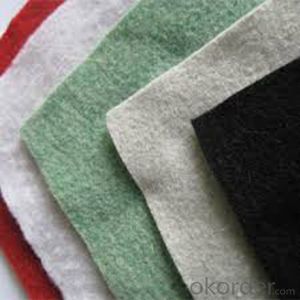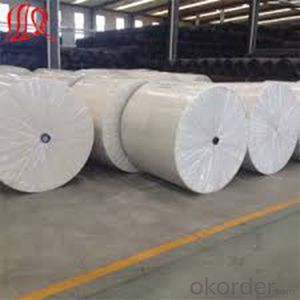Non-Woven Geotextile for Highway,Railway,Dam
- Loading Port:
- China main port
- Payment Terms:
- TT OR LC
- Min Order Qty:
- 3000 m²
- Supply Capability:
- 1000000 m²/month
OKorder Service Pledge
OKorder Financial Service
You Might Also Like
Item specifice
Thermal bonded Non-Woven geotextile


2. Features
Filament geotextile has features as follows: High strength, good capacity of elongation and high biology tolerance, alkali tolerance, acidity tolerance, weather resistance good filtration and fine drainage capacity etc. Also it is of low cost, easy in construction and use effects
3. Geotextile Applications
1) Filtration :
1) Weight / Mass: 100g/m2-800g/m2
2) Width: Within 6 m (1m-6m)
3) Length: 50m-100m/roll (as request)
4) Material: PP / PET
Our Service
Quality assurance
1.On a regular basis or as per your request,we entrust national testing agencies to conduct quality inspections
2. Strictly in accordance with the ISO9001-2008 international quality system standard,we monitor and manage the whole process throughout production,quality testing,and measurement to ensure product quality
3. For quality-related construction delay or substandard construction(except for damage or losses due to customer’s responsibility or irresistible natural disasters),we have refunding,replacement,and repair services.We will respond to customers’ feedbacks on quality issues within 24 hours.
FQR
Q: What kind of payments does jenor support?
A: T/T, L/C, Cash are accepted.
Q: Do you charge for the samples?
A: Accordeing to our company policy, the samples are free, we only charge the freight fee. And we will return the freight fee during the next order.
Q: Can you produce according to customers' design?
A: Sure, we are professional manufacturer, OEM and ODM are both welcome.
Q: Do you have other products?
A: Yes, please check the pictures:
Packaging & Shipping
Packing: PLASTIC FILM INSIDE, AND WOVEN BAG OUTSIDE
Shipping: About 15 days after receipt the deposit
geotextile fabric
permeability,filtration,easy for construction
ISO and CE certificate
Good quality and competitive price
- Q:How do geotextiles help with load support in unpaved roads?
- Geotextiles help with load support in unpaved roads by providing a stable base and preventing the mixing of different soil layers. They act as a barrier between the road surface and the underlying soil, distributing the load evenly and reducing the risk of rutting and deformation. Additionally, geotextiles enhance the drainage capabilities of the road, improving its overall strength and durability.
- Q:How do geotextiles contribute to the safety of transportation infrastructure?
- Geotextiles play a crucial role in enhancing the safety of transportation infrastructure by providing soil stabilization, erosion control, and drainage management. They prevent soil movement and erosion, which can undermine the stability of roads, slopes, and embankments. Geotextiles also help improve the load-bearing capacity of the soil, reducing the risk of structural failure or settlement. Additionally, these materials promote effective drainage by allowing water to pass through while filtering out fine particles, preventing waterlogging and soil saturation. Overall, geotextiles contribute to the overall durability, longevity, and safe functioning of transportation infrastructure.
- Q:Geotextile how to sampling
- Related methods can refer to GB-1998, can also go to our factory to purchase, to observe. My contact is the name of the registration. Free testing training! All the country's site can be shipped!
- Q:What are the different geotextile reinforcement techniques for slopes?
- Some of the different geotextile reinforcement techniques for slopes include the use of geotextile fabrics, geogrids, and geocells. Geotextile fabrics are commonly used to stabilize slopes by providing separation and filtration of soil particles. Geogrids, on the other hand, are high-strength materials that are used to reinforce soil and increase its stability. Geocells are three-dimensional cellular structures that can be filled with soil or other materials to create a stable slope. These techniques can be used individually or in combination to provide effective reinforcement for slopes and prevent erosion.
- Q:What are the different geotextile tensile strength test methods?
- There are several different geotextile tensile strength test methods, including the grab test, strip test, wide-width strip test, and trapezoid tear test. Each method has its own advantages and is used to evaluate the tensile strength and performance of geotextiles in different applications.
- Q:What are the applications of geotextiles in landscaping?
- Geotextiles have various applications in landscaping, including erosion control, soil stabilization, and weed suppression. They can be used to prevent soil erosion on slopes, retain soil in embankments, and enhance the stability of retaining walls. Geotextiles also act as a barrier to prevent weed growth, reducing the need for herbicides. Additionally, these textiles can be employed in drainage systems to improve water filtration and prevent soil compaction. Overall, geotextiles provide valuable solutions for improving the sustainability and longevity of landscaping projects.
- Q:How do geotextiles reduce hydraulic pressure in soil?
- Geotextiles reduce hydraulic pressure in soil by allowing water to flow through them, thereby acting as a drainage layer. This helps to prevent the build-up of water pressure within the soil, which can lead to soil erosion and instability.
- Q:What are the considerations for geotextile selection in road rehabilitation projects?
- When selecting geotextiles for road rehabilitation projects, there are several important considerations to keep in mind. Firstly, the geotextile should have sufficient strength and durability to withstand the expected loads and stresses in the road environment. It should also be resistant to degradation from environmental factors such as ultraviolet (UV) radiation and chemicals. Another consideration is the desired function of the geotextile. Different types of geotextiles offer various benefits, such as separation, filtration, drainage, or reinforcement. The specific requirements of the road project will determine which function is most important. Additionally, the properties of the soil and subgrade should be considered when selecting a geotextile. The geotextile should be compatible with the soil type and provide the necessary soil stabilization or separation capabilities. It is crucial to assess the project's soil conditions and consult with geotechnical engineers or experts to determine the appropriate geotextile specifications. Lastly, cost-effectiveness is an essential consideration. The selected geotextile should provide the desired performance while being economically viable for the project. Considering the long-term benefits and expected lifespan of the geotextile can help in making a cost-effective decision. Overall, the considerations for geotextile selection in road rehabilitation projects involve strength, durability, desired function, compatibility with soil conditions, and cost-effectiveness.
- Q:Can geotextiles be used in railway track stabilization?
- Yes, geotextiles can be used in railway track stabilization. Geotextiles provide reinforcement and separation functions, preventing the mixing of materials and improving the stability of the track. They can help distribute loads, reduce deformation, and enhance the overall performance and lifespan of the railway track.
1. Manufacturer Overview |
|
|---|---|
| Location | |
| Year Established | |
| Annual Output Value | |
| Main Markets | |
| Company Certifications | |
2. Manufacturer Certificates |
|
|---|---|
| a) Certification Name | |
| Range | |
| Reference | |
| Validity Period | |
3. Manufacturer Capability |
|
|---|---|
| a)Trade Capacity | |
| Nearest Port | |
| Export Percentage | |
| No.of Employees in Trade Department | |
| Language Spoken: | |
| b)Factory Information | |
| Factory Size: | |
| No. of Production Lines | |
| Contract Manufacturing | |
| Product Price Range | |
Send your message to us
Non-Woven Geotextile for Highway,Railway,Dam
- Loading Port:
- China main port
- Payment Terms:
- TT OR LC
- Min Order Qty:
- 3000 m²
- Supply Capability:
- 1000000 m²/month
OKorder Service Pledge
OKorder Financial Service
Similar products
New products
Hot products
Related keywords































